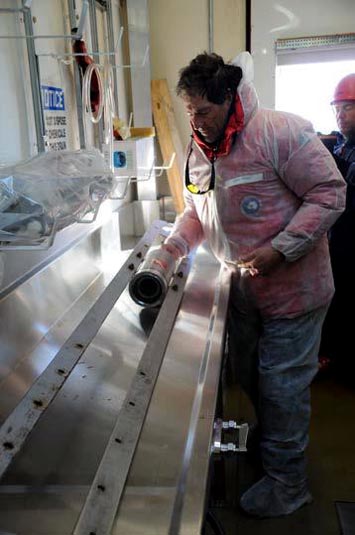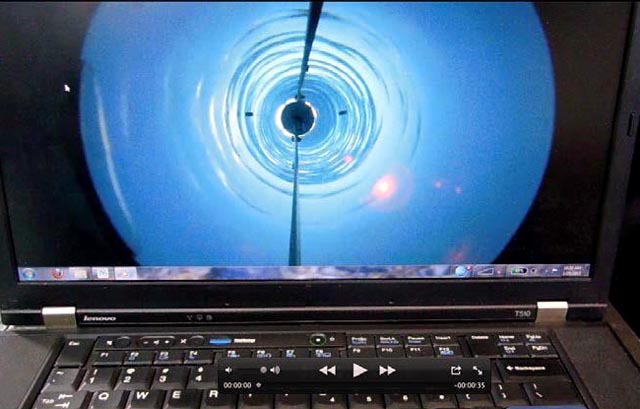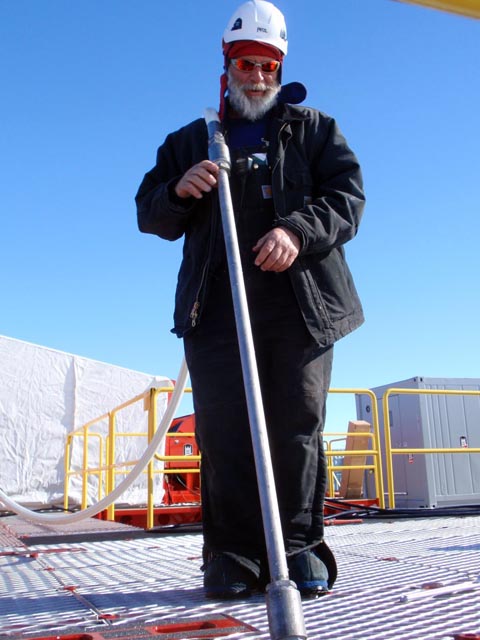|
Water worldU.S. researchers breach Antarctic subglacial lake in search for extreme lifePosted January 28, 2013
In the end, it took a little bit of magic and quite a lot of effort, but U.S. scientists announced this week that they successfully reached a lake buried nearly a kilometer below the West Antarctic Ice Sheet. Previous Coverage
The moment came on Jan. 27 (local New Zealand time) when scientists and drillers with the Whillans Ice Stream Subglacial Access Research Drilling (WISSARD) The researchers will spend the rest of the week retrieving water and sediment samples from the lake, which may contain microscopic life that scientists will study to learn about how organisms evolve in such extreme environments. The interdisciplinary project will also collect data to understand fundamental questions about climate history and ice sheet dynamics in Antarctica. The effort marks the first successful retrieval of clean whole samples from an Antarctic subglacial lake, according to a press release from the WISSARD team. 
Photo Credit: WISSARD
WISSARD chief scientist John Priscu prepares a camera to go down the borehole.
“WISSARD’s groundbreaking exploration of Antarctica’s subglacial environment marks the beginning of a new era in polar science, opening the window for future interdisciplinary scientific investigations of one of Earth’s last unexplored frontiers,” the team said in a joint statement. Science journalist Doug Fox, embedded with the project and reporting for Discover magazine, wrote from the field For instance, Fox wrote that the lake is only a couple of meters deep, much less than expected based on earlier surveys using seismic instruments to image the subglacial lake through the ice sheet. However, the big news appears to be the discovery of diatoms from mud that was stuck to the hotwater drill nozzle after it penetrated into the lake. The mud, Fox wrote, was smeared out on slides and viewed under a microscope at on-site lab. The sample revealed what Fox called “the clear glassy shells” of dead diatoms, photosynthetic organisms that would have lived in the upper, light-filled waters when it was a shallow sea not covered by ice. “Those diatoms are only a first glimpse — fortuitously salvaged from the drill. But Lake Whillans is also being sampled for present-day life. Those results are still to come,” Fox concluded in his field report on Discover magazine’s website. This week’s achievement is the culmination of more than a decade of international and national planning and more than three years of project preparation by the WISSARD consortium of U.S. universities and two international contributors. There are 13 WISSARD principal investigators representing eight different U.S. institutions. The penetration of the lake follows a tense week of weather delays that prevented the scientists and drillers from reaching the field camp, located near the Texas-sized Ross Ice Shelf. The first couple of weeks in January were spent hauling the hotwater drill equipment and scientific cargo across the ice shelf with tractors. The researchers will have until the end of this week to sample the lake before flying back to McMurdo Station The National Science Foundation The U.S. triumph follows a failed attempt by the British Antarctic Survey (BAS) Meanwhile, Russia’s Arctic and Antarctic Research Institute While all three projects are studying subglacial lakes, each environment is different. Lake Vostok is believed to have been isolated for millions of years. Lake Ellsworth may have occupied an ancient fjord for hundreds of thousands of years. Lake Whillans is more like a wetland, with the lake periodically filling and draining. NSF-funded research in this story: John Priscu, Mark Skidmore and Andrew Mitchel, Montana State University, Award No. 0838933 |



For USAP Participants |
For The Public |
For Researchers and EducatorsContact UsU.S. National Science FoundationOffice of Polar Programs Geosciences Directorate 2415 Eisenhower Avenue, Suite W7100 Alexandria, VA 22314 Sign up for the NSF Office of Polar Programs newsletter and events. Feedback Form |



